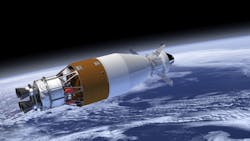NASA's Space Launch System Exploration Upper Stage completes critical design review
HUNTSVILLE, Ala., - Boeing and NASA have successfully completed a critical design review for NASA’s Space Launch System (SLS) Exploration Upper Stage (EUS), confirming the EUS design for continued development and transition to hardware build. Boeing has already started fabrication activities that will support building the first EUS at NASA’s Michoud Assembly Facility in New Orleans.
The SLS rocket uses staged propulsion to send NASA’s Orion spacecraft and astronauts, plus supplies, to the moon and beyond. The Boeing-built core stage powers the SLS in early flight, eventually separating when the upper stage takes over and provides the power to send crewed vehicles, space habitats and other payloads on to the moon or other deep space destinations.
To accomplish NASA’s Artemis I lunar mission, the Block 1 variant of SLS will use a Boeing/United Launch Alliance Interim Cryogenic Propulsion Stage with one RL-10 engine to take an uncrewed Orion spacecraft on a test flight to the moon. SLS Block 1 rockets will be used for two subsequent crewed flights, including the first human mission to lunar orbit since the Apollo program.
The next version of SLS, Block 1B, will use EUS, which has larger fuel tanks and four RL-10 engines to give it a performance boost. That will allow SLS Block 1B to carry an Orion with a crew of four, as well as more than 10 metric tons of co-manifested payload.
